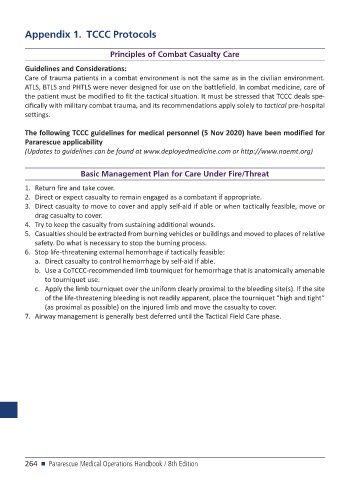Page 266 - PJ MED OPS Handbook 8th Ed
P. 266
Appendix 1. TCCC Protocols
Principles of Combat Casualty Care
Guidelines and Considerations:
Care of trauma patients in a combat environment is not the same as in the civilian environment.
ATLS, BTLS and PHTLS were never designed for use on the battlefield. In combat medicine, care of
the patient must be modified to fit the tactical situation. It must be stressed that TCCC deals spe-
cifically with military combat trauma, and its recommendations apply solely to tactical pre-hospital
settings.
The following TCCC guidelines for medical personnel (5 Nov 2020) have been modified for
Pararescue applicability
(Updates to guidelines can be found at www.deployedmedicine.com or http://www.naemt.org)
Basic Management Plan for Care Under Fire/Threat
1. Return fire and take cover.
2. Direct or expect casualty to remain engaged as a combatant if appropriate.
3. Direct casualty to move to cover and apply self-aid if able or when tactically feasible, move or
drag casualty to cover.
4. Try to keep the casualty from sustaining additional wounds.
5. Casualties should be extracted from burning vehicles or buildings and moved to places of relative
safety. Do what is necessary to stop the burning process.
6. Stop life-threatening external hemorrhage if tactically feasible:
a. Direct casualty to control hemorrhage by self-aid if able.
b. Use a CoTCCC-recommended limb tourniquet for hemorrhage that is anatomically amenable
to tourniquet use.
c. Apply the limb tourniquet over the uniform clearly proximal to the bleeding site(s). If the site
of the life-threatening bleeding is not readily apparent, place the tourniquet “high and tight”
(as proximal as possible) on the injured limb and move the casualty to cover.
7. Airway management is generally best deferred until the Tactical Field Care phase.
264 n Pararescue Medical Operations Handbook / 8th Edition

